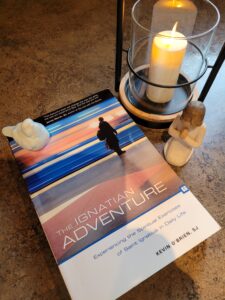An Ignatian Journey with Debbie

You can sign up to receive the writings or they are available here
If you would like to receive what I will share about my Ignatian Journey, subscribe below and you will receive them into your email from Monday to Friday.
Alternatively, I will put the writings of each day here. The current day will be all that is available this way.
The Story of the man behind the Spiritual Exercises (Ignatian Journey)
Preparing for the Ignatian Adventure
I purchased “The Ignatian Adventure” in 2015 and here we are in 2024, when I am actually going to embark on this journey. I am very excited. Nine months of journeying with others through the Ignatian Exercises begins in a few short weeks.
I don’t know about you, but there are times on my faith journey where I need a new tool, or plan or way of engaging with God – to refresh my side of the relationship! The Ignatian Spiritual Exercises are that tool for me now. I hope that in sharing my journey with Christ within them will be a blessing to you on your faith journey!
I thought I would tell you a bit about Ignatius first, because these exercises originate with him and come out of his life with Christ.
Ignatius was born in the ancestral castle of the Loyolas in the Basque province of Guipúzcoa, (Spain) the youngest of 13 children of a noble and wealthy family; his mother died when he was seven years old. In 1506 Ignatius became a page in the service of a relative, Juan Velázquez de Cuéllar, treasurer of the kingdom of Castile. In 1517 Ignatius became a knight in the service of another relative, Antonio Manrique de Lara, duke of Nájera and viceroy of Navarre, who employed him in military undertakings and on a diplomatic mission.
While defending the citadel of Pamplona against the French, Ignatius was hit by a cannonball on May 20, 1521, sustaining a bad fracture of his right leg and damage to his left. This event closed the first period of his life, during which he was, on his own admission, “a man given to the vanities of the world, whose chief delight consisted in martial exercises, with a great and vain desire to win renown”
It is the second period of Ignatius’s life, in which he turned toward a saintly life, that is the better known. After treatment at Pamplona, he was transported to Loyola in June 1521. There his condition became so serious that for a time it was thought he would die. When out of danger, he chose to undergo painful surgery to correct blunders made when the bone was first set. The result was a convalescence of many weeks (around six months), during which he read a life of Christ and a book on the lives of the saints, the only reading matter the castle afforded.
As he read these books, he noticed a change taking place within him. Daydreams of serving the king as a valiant knight and winning the love of a noble lady, though at first enticing, ultimately left him feeling inwardly dry and discontented. By contrast, when he imagined devoting his life to the service of God and others, as had the saints he was reading about, he experienced a deep sense of joy. God was stirring up something new and Ignatius became convinced that God was speaking to him through his interior attractions and reactions.
Story to be continued…
Sept 5-24
Story Continued…
Once recovered from his injuries, Ignatius began to travel towards Jerusalem. He left behind his stately family home, begging, preaching and caring for the sick and poor. He visited monasteries, laid down his sword, engaged in long times of prayer. He discerned carefully the interior movements of his soul: the attractions, feelings, thoughts, and desires that led him to greater intimacy with Jesus Christ and those that were distractions to his spiritual growth.
At this time, he tried to outdo the piety of the saints he read about; he engaged in severe bodily penances. But he was shown that his seemingly pious acts were really displays of vanity. As he sought a more balanced spiritual life, he encountered a God who was not a tyrant waiting for him to slip up but a helping God who wanted for him the fullness of life.
Ignatius experienced revelation that allowed him to the world with new eyes and to find God in all things. He wrote that he learned more about God and the world in that one moment than he did throughout the rest of his life.
He began to make notes of his spiritual insights. He talked to people about the spiritual whenever and wherever he could and recorded the fruit of these conversations. Those notes became the basis for a manual of prayer that he would later title the Spiritual Exercises (this is what I am referring to as The Ignatian Adventure).

